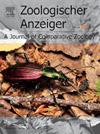蝌蚪形态的进化:从两种新形态(无尾目、细足目、细足目)的描述,首次了解小绒猴类群的幼虫多样性
IF 1.5
3区 生物学
Q2 ZOOLOGY
引用次数: 0
摘要
在巴西东南部高海拔地区分布有4个种。在本研究中,我们描述了其中两个物种,Physalaemus claptoni和P. deimaticus的蝌蚪,并探讨了该群体的体型进化。P. claptoni和P. deimaticus的外部特征与该组其他物种相同,但P. claptoni的身体较大且呈球形,P. deimaticus与其姊妹种Physalaemus erythros非常相似,P3齿列与P2齿列长度相同,边缘下乳头呈排状分布。基于几何形态计量学的形态空间分析表明,P. deimaticus类群的物种表现出广泛的形状,包括在Physalaemus符号分支中发现的大部分变异。因此,尽管形态和生境类型之间的生态形态学相关性(即,lltic /lotic梯度)在较窄的系统发育尺度上(即,在P. deimaticus组内)是明显的,但在更广泛的系统发育背景下(即,P. signifer组),它们变得模糊。尽管存在普遍的同形现象,而且在P. signifer类群的体型进化中缺乏重要的转变,但优化结果检索到P. deimaticus和P. erythros共同祖先的形状变化,支持它们之间的密切关系。我们的研究结果表明,系统发育形态计量学方法对于描述蝌蚪形状的进化是有效的,蝌蚪形状是一组不易被离散特征或线性测量捕获的特征。此外,对Physalaemus的两只蝌蚪的描述增加了对该属幼虫多样性的认识。本文章由计算机程序翻译,如有差异,请以英文原文为准。
The evolution of tadpole shape: first insights into larval diversity of the Physalaemus deimaticus group with the description of two new forms (Anura, Leptodactylidae, Leiuperinae)
The Physalaemus deimaticus species group comprises four species distributed in high-altitude areas in southeastern Brazil. In this study we describe the tadpoles of two of these species, Physalaemus claptoni and P. deimaticus, and explore the body shape evolution in the group. Both species share external features with the other species of the group, but P. claptoni presents a larger and globular body, while P. deimaticus is quite similar to Physalaemus erythros, its sister species, sharing a P3 tooth row of the same length than P2, and submarginal papillae distributed in rows. The phylomorphospace analysis based on geometric morphometrics demonstrated that species of the P. deimaticus group exhibit a wide range of shapes, encompassing a great part of the variation found in the Physalaemus signifer clade. Thus, although ecomorphological correlations between shape and habitat type (i.e., lentic/lotic gradient) are evident at a narrower phylogenetic scale (i.e., within the P. deimaticus group), they become ambiguous when examined at a broader phylogenetic context (i.e., P. signifer group). Despite the general homoplasy scenario and the absence of important transformations in the evolution of body shape of the P. signifer group, the optimizations retrieved shape changes for the common ancestor of P. deimaticus and P. erythros, supporting their close relationship. Our results show that phylogenetic morphometric methods are effective for describing the evolution of tadpole shape, a set of traits not easily captured by discrete characters or linear measurements. Furthermore, the description of two tadpoles of Physalaemus increases knowledge of the larval diversity of the genus.
求助全文
通过发布文献求助,成功后即可免费获取论文全文。
去求助
来源期刊

Zoologischer Anzeiger
生物-动物学
CiteScore
2.80
自引率
7.10%
发文量
75
审稿时长
>12 weeks
期刊介绍:
Zoologischer Anzeiger - A Journal of Comparative Zoology is devoted to comparative zoology with a special emphasis on morphology, systematics, biogeography, and evolutionary biology targeting all metazoans, both modern and extinct. We also consider taxonomic submissions addressing a broader systematic and/or evolutionary context. The overall aim of the journal is to contribute to our understanding of the organismic world from an evolutionary perspective.
The journal Zoologischer Anzeiger invites suggestions for special issues. Interested parties may contact one of the editors.
 求助内容:
求助内容: 应助结果提醒方式:
应助结果提醒方式:


